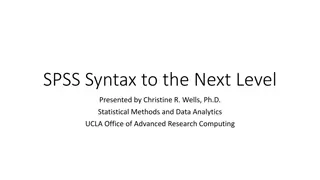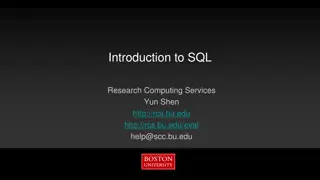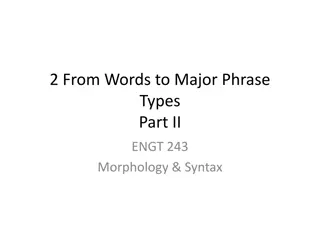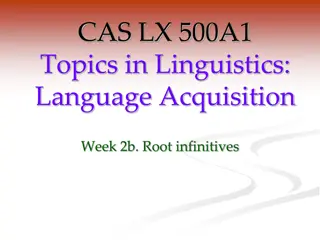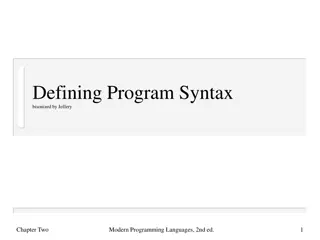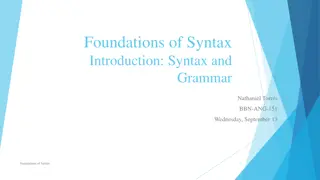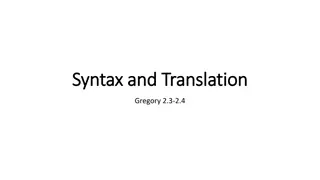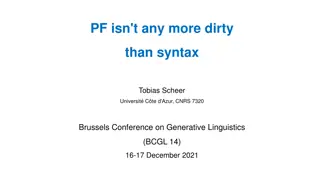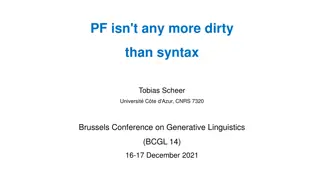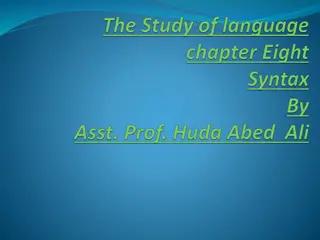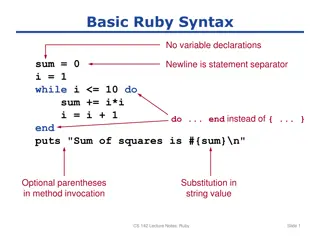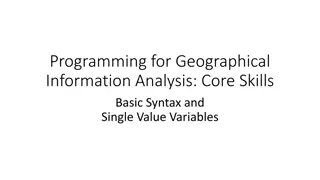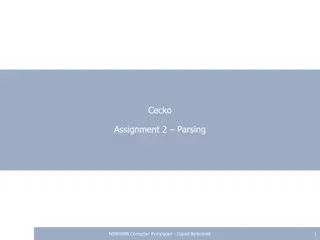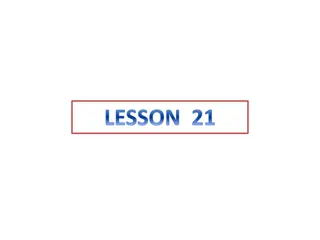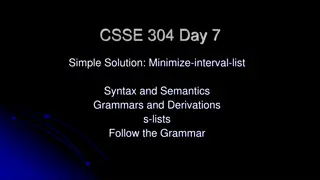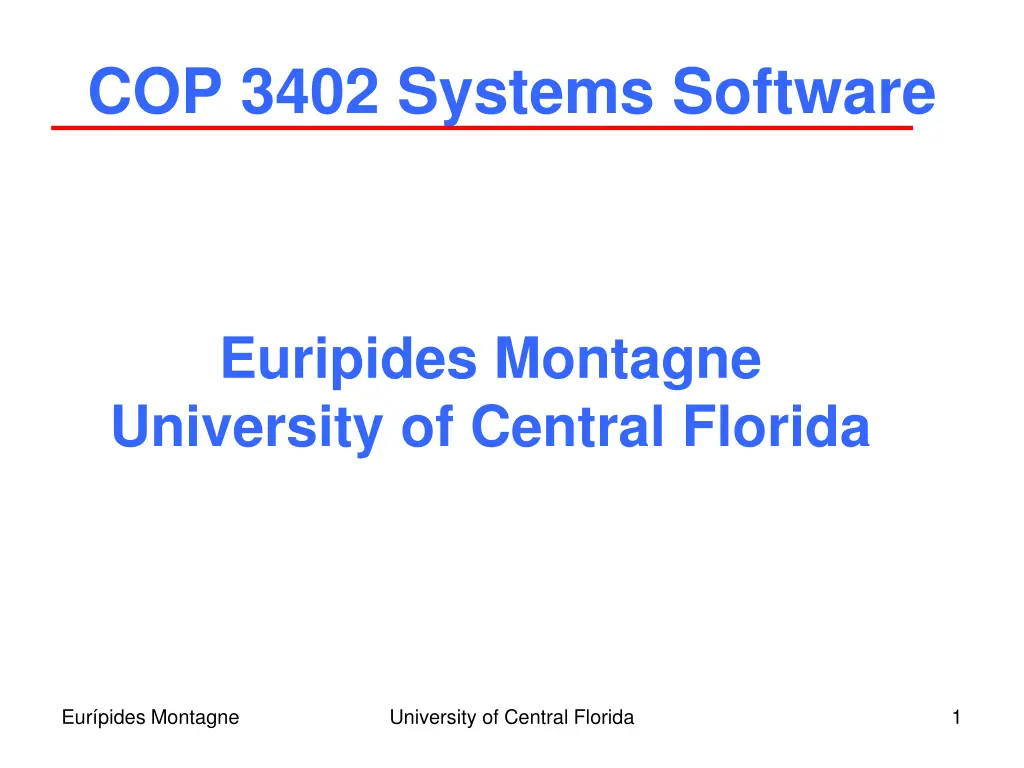
Understanding Context-Free Grammars in Systems Software
Explore the concepts of context-free grammars in systems software, including syntax analysis, ambiguous and unambiguous grammars, and the role of recursion in expressing nested structures. Learn about regular languages, parsing techniques, and the significance of Context-Free Languages (CFL) in recognizing patterns. Dive into examples, rules, and applications of context-free grammars in programming languages.
Download Presentation

Please find below an Image/Link to download the presentation.
The content on the website is provided AS IS for your information and personal use only. It may not be sold, licensed, or shared on other websites without obtaining consent from the author. If you encounter any issues during the download, it is possible that the publisher has removed the file from their server.
You are allowed to download the files provided on this website for personal or commercial use, subject to the condition that they are used lawfully. All files are the property of their respective owners.
The content on the website is provided AS IS for your information and personal use only. It may not be sold, licensed, or shared on other websites without obtaining consent from the author.
E N D
Presentation Transcript
COP 3402 Systems Software Euripides Montagne University of Central Florida Eur pides Montagne University of Central Florida 1
COP 3402 Systems Software Syntax analysis (Parser) Eur pides Montagne University of Central Florida 2
Outline 1. Parsing 2. Context Free Grammars 3. Ambiguous Grammars 4. Unambiguous Grammars Eur pides Montagne University of Central Florida 3
Parsing In a regular language nested structures can not be expressed. Nested structures can be expressed with the aid of recursion. For example, A FSA cannot suffice for the recognition of sentences in the set { anbn | n is in { 0, 1, 2, 3, }} where a represents ( or { and b represents ) or } Eur pides Montagne University of Central Florida 4
Parsing So far we have been working with three rules to define regular sets (regular languages): Concatenation (s r) Alternation (choice) (s | r) Kleene closure (repetition) ( s )* Regular sets are generated by regular expressions and recognized by scanners (FSA). Adding recursion as an additional rule we can define context free languages. Eur pides Montagne University of Central Florida 5
Context Free Grammars Any string that can be defined using concatenation, alternation, Kleene closure and recursion is called a Context Free Language (CFL). CFLs are generated by Context Free Grammars (CFG) and can recognize by Pushdown Automatas. Every language displays a structure called its grammar Parsing is the task of determining the structure or syntax of a program. Eur pides Montagne University of Central Florida 6
Context Free Grammars Let us observe the following three rules (grammar): 1) <sentence> <subject> <predicate> Where means is defined as 2) <subject> John | Mary 3) <predicate> eats | talks where | means or With this rules we define four possible sentences: John eats John talks Mary eats Mary talks Eur pides Montagne University of Central Florida 7
Context Free Grammars We will refer to the formulae or rules used in the former example as : Syntax rules, productions, syntactic equations, or rewriting rules. <subject> and <predicate> are syntactic classes or categories. Using a shorthand notation we can write the following syntax rules L = { ac, ad, bc, bd} = set of sentences S A B L is called the language that can be generated by the syntax rules by repeated substitution. A a | b B c | d Eur pides Montagne University of Central Florida 8
Context Free Grammars Definition : A language is a set of strings of characters from some alphabet. The strings of the language are called sentences or statements. A string over some alphabet is a finite sequence of symbols drawn from that alphabet. A meta-language is a language that is used to describe another language. Eur pides Montagne University of Central Florida 9
Context Free Grammars A very well known meta-language is BNF (Backus Naur Form) It was developed by John Backus and Peter Naur, in the late 50s, to describe programming languages. Noam Chomsky in the early 50s developed context free grammars which can be expressed using BNF. Eur pides Montagne University of Central Florida 10
Context Free Grammars A context free language is defined by a 4-tuple (T, N, R, S) as: (1) The set of terminal symbols (T) * They can not be substituted by any other symbol * This set is also called the vocabulary S <A> <B> <A> a | b Terminal Symbols (Tokens) <B> c | d Eur pides Montagne University of Central Florida 11
Context Free Grammars A context free language is defined by a 4-tuple (T, N, R, S) as: (2) The set of non-terminal symbols (N) * They denote syntactic classes * They can be substituted {S, A, B} by other symbols non terminal symbols S <A> <B> <A> a | b <B> c | d Eur pides Montagne University of Central Florida 12
Context Free Grammars A context free language is defined by a 4-tuple (T, N, R, S) as: (3) The set of syntactic equations or productions (the grammar). * An equation or rewriting rule is specified for each non- terminal symbol (R) S <A> <B> <A> a | b Productions <B> c | d Eur pides Montagne University of Central Florida 13
Context Free Grammars A context free language is defined by a 4-tuple (T, N, R, S) as: (4) The start Symbol (S) S <A> <B> <A> a | b <B> c | d Eur pides Montagne University of Central Florida 14
Context Free Grammars Example of a grammar for a small language: <program> begin <stmt-list> end <stmt-list> <stmt> | <stmt> ; <stmt-list> <stmt> <var> = <expression> <expression> <var> + <var> | <var> - <var> | <var> Eur pides Montagne University of Central Florida 15
Context Free Grammars A sentence generation is called a derivation. The statement a := b * ( a + c ) Is generated by the left most derivation: Grammar for a simple assignment statement: <assgn> <id> := <expr> a := <expr> a := <id> * <expr> a := b * <expr> a := b * ( <expr> ) R5 a := b * ( <id> + <expr> ) R3 a := b * ( a + <expr> ) R2 a := b * ( a + <id> ) a := b * ( a + c ) R1 R2 R4 R2 R1 <assgn> R2 <id> R3 <expr> R4 R5 R6 | <id> <id> := <expr> a | b | c <id> + <expr> | <id> * <expr> | ( <expr> ) R6 R2 In a left most derivation only the left most non-terminal is replaced Eur pides Montagne University of Central Florida 16
Parse Trees A parse tree is a graphical representation of a derivation For instance the parse tree for the statement a := b * ( a + c ) is: <assign> <id> := <expr> a <id> * <expr> Every internal node of a parse tree is labeled with a non-terminal symbol. b ( <expr> ) <id> + <expr> Every leaf is labeled with a terminal symbol. a <id> c Eur pides Montagne University of Central Florida 17
Ambiguity A grammar that generates a sentence for which there are two or more distinct parse trees is said to be ambiguous For instance, the following grammar is ambiguous because it generates distinct parse trees for the expression a := b + c * a <assgn> <id> <expr> | <id> <id> := <expr> a | b | c <expr> + <expr> | <expr> * <expr> | ( <expr> ) Eur pides Montagne University of Central Florida 18
Ambiguity <assign> <assign> <id> := <expr> <id> := <expr> A <expr> * <expr> A <expr> + <expr> <expr> * <expr> <id> <expr> + <expr> <id> B <id> <id> <id> <id> A C A B C This grammar generates two parse trees for the same expression. If a language structure has more than one parse tree, the meaning of the structure cannot be determined uniquely. Eur pides Montagne University of Central Florida 19
Ambiguity Operator precedence: If an operator is generated lower in the parse tree, it indicates that the operator has precedence over the operator generated higher up in the tree. An unambiguos grammar for expressions: <assign> <id> <expr> <term> <factor> | <id> <id> := <expr> a | b | c <expr> + <term> | <term> <term> * <factor> | <factor> ( <expr> ) This grammar indicates the usual precedence order of multiplication and addition operators. This grammar generates unique parse trees independently of doing a rightmost or leftmost derivation Eur pides Montagne University of Central Florida 20
Ambiguity Leftmost derivation: <assgn> <id> := <expr> a := <expr> a := <expr> + <term> a := <term> + <term> a := <factor> + <term> a := <id> + <term> a := b + <term> a := b + <term> *<factor> a := b + <factor> * <factor> a := b + <id> * <factor> a := b + c * <factor> a := b + c * <id> a := b + c * a Rightmost derivation: <assgn> <id> := <expr> <id> := <expr> + <term> <id> := <expr> + <term> *<factor> <id> := <expr> + <term> *<id> <id> := <expr> + <term> * a <id> := <expr> + <factor> * a <id> := <expr> + <id> * a <id> := <expr> + c * a <id> := <term> + c * a <id> := <factor> + c * a <id> := <id> + c * a <id> := b + c * a a := b + c * a Eur pides Montagne University of Central Florida 21
Ambiguity Dealing with ambiguity: Rule 1: * (times) and / (divide) have higher precedence than + (plus) and (minus). Example: a + c * 3 a + ( c * 3) Rule 2: Operators of equal precedence associate to the left. Example: a + c + 3 (a + c) + 3 Eur pides Montagne University of Central Florida 22
Ambiguity Dealing with ambiguity: Rewrite the grammar to avoid ambiguity. The grammar: <expr> <op> <expr> <op> <expr> | id | int | (<expr>) + | - | * | / Can be rewritten it as: <expr> <term> <factor> <term> | <expr> + <term> | <expr> - <term> <factor> | <term> * <factor> | <term> / <factor>. id | int | (<expr>) Eur pides Montagne University of Central Florida 23
Ambiguity Is this grammar ambiguous? E T | E + T | E - T T F | T * F | T / F F id | num | ( E ) Parse id + id id Is this grammar ambiguous? E T | E + T T F | T * F F id | ( E ) Parse id + id + id Eur pides Montagne University of Central Florida 24
Ambiguity Is this grammar ambiguous? E E + E | id Parse id + id + id Is this grammar ambiguous? E E + id | id Parse id + id + id Eur pides Montagne University of Central Florida 25
Ambiguity Example: Given the ambiguous grammar E E + E | E * E | ( E ) | id We could rewrite it as: E E + T | T T T * F | F F id | ( E ) Find the parse three for: Id + id * id Eur pides Montagne University of Central Florida 26
Recursive descent parsing Ambiguity if not the only problem associated with recursive descent parsing. Other problems to be aware of are left recursion and left factoring: Left recursion: A grammar is left recursive if it has a non-terminal A such that there is a derivation A A for some string Top-down parsing methods can not handle left-recursive grammars, so a transformation is needed to eliminate left recursion. For example, the pair of productions: A A could be replaced by the non-left-recursive productions: A A A A | Eur pides Montagne University of Central Florida 27
Recursive descent parsing Left factoring: Left factoring is a grammar transformation that is useful for producing a grammar suitable for predictive (top-down) parsing. When the choice between two alternative A-production is not clear, we may be able to rewrite the production to defer the decision until enough of the input has been seen thus we can make the right choice. For example, the pair of productions: A 1 | 2 could be left-factored to the following productions: A A A 1 | 2 Eur pides Montagne University of Central Florida 28
Recursive descent parsing Given the following grammar: E E + E | T T T * F | F F id | ( E ) To avoid left recursion we can rewrite it as: E E T F T T * F T | F ( E ) | id T E + T E | Eur pides Montagne University of Central Florida 29
COP 3402 Systems Software Euripides Montagne University of Central Florida Eur pides Montagne University of Central Florida 30


